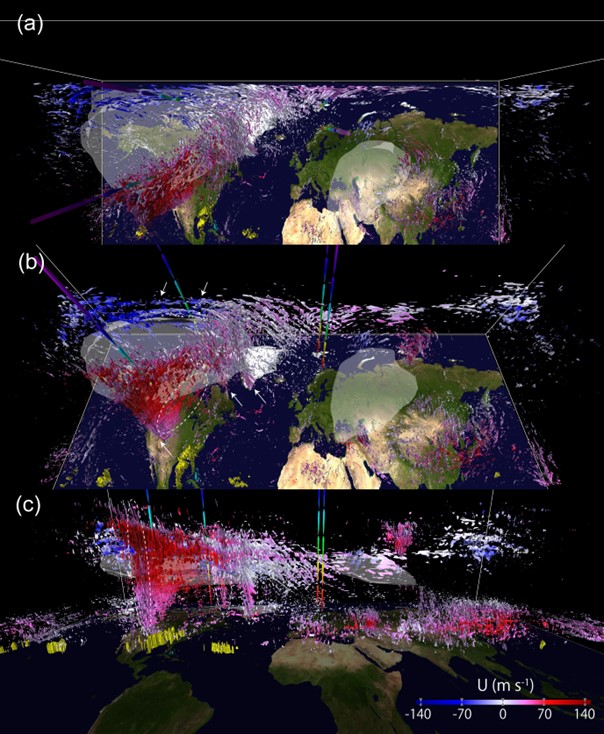DATE2022.10.05 #Press Releases
Successful detailed simulation and visualization of atmospheric gravity waves during stratospheric sudden warming
Overview of the press release
Shingo Watanabe of the Research Center for Environmental Modeling and Application, Japan Agency for Marine–Earth Science and Technology (JAMSTEC), and Dai Koshin, a third-year PhD student in the Department of Earth and Planetary Science, Graduate School of Science, the University of Tokyo, Shunsuke Noguchi, an assistant professor in the Graduate School of Science, Kyushu University, and Kaoru Sato, a professor in the Graduate School of Science, the University of Tokyo, have conducted a study on the characteristics of atmospheric gravity waves generated during stratospheric sudden warming. By performing detailed simulations and visualization of atmospheric gravity waves generated during stratospheric sudden warming, they have succeeded in clarifying the characteristic morphology of atmospheric gravity waves that deform dramatically around the polar vortex.
Atmospheric gravity waves are a type of oscillation generated when the atmosphere is shaken up and down by various mechanisms, and they propagate through the atmosphere in three dimensions. They are known to play an important role in the formation of atmospheric general circulation in the stratosphere and mesosphere because of their momentum-carrying property and their role in accelerating the surrounding atmosphere and mixing materials when they dissipate at the destination. On the other hand, it has been difficult for sensors used for observation to continuously capture the focused atmospheric gravity waves due to their nature of being fixed to the ground or mounted on balloons or satellites, and thus the life cycle of various types of atmospheric gravity waves has been a mystery.
In this study, detailed simulations of atmospheric gravity waves were performed using atmospheric fields that correspond to observed facts, and the results were visualized and analyzed to clarify the lives of various types of atmospheric gravity waves. The period of interest for this simulation is the stratospheric sudden warming event that occurred in February 2018. During this event, the "polar vortex," which normally covers the Arctic, split into two parts with centers over North America and Central Asia. As a result of observing the distribution of atmospheric gravity waves generated during this event from various perspectives, a swarm of atmospheric gravity waves with a characteristic funnel-like shape was observed in the vicinity of the polar vortex over North America. This was discovered for the first time in this simulation. (See Figure (b).
Furthermore, by combining 3D movie analysis and ray tracing analysis, the research team was able to clarify the origin and propagation path of these atmospheric gravity waves. The most notable example is a new image of atmospheric gravity waves that travel thousands of kilometers along the edge of the polar vortex over North America, rotating widely counterclockwise and rising to an altitude of around 50-70 km, a much longer distance than previously imagined by researchers.
This research result indicates that the conventional assumption that generated atmospheric gravity waves propagate only almost directly upward, which is used in the gravity wave parameterization of weather forecasting and climate prediction models, does not hold in many cases, and that atmospheric gravity waves propagating from unexpected places can impart momentum carried at unexpected times to the surrounding atmosphere, causing sudden changes in stratospheric and mesospheric winds and mixing of materials.
Further in-depth studies are expected to reveal the mysterious behavior of atmospheric gravity waves and the role played by the unknown teleconnection caused by these waves.

Fig : A "showcase view" of the 3D visualization results of a detailed simulation of atmospheric gravity waves during a stratospheric sudden warming event (February 12, 2018). The atmospheric gravity waves are colored by the in-situ east-west winds, with red for eastward winds and blue for westward winds. Four columns colored red, yellow, green, cyan, blue, and purple from the ground represent approximate heights (painted at 20 km intervals).
【Supplemental】A 3D propagating atmospheric gravity wave looks like a wave when viewed in one- or two-dimensional cross sections, but in 3D space, it has the appearance of a folded entity made up of long, thin bars, grains, flat plates, elliptical line segments, etc., and is therefore represented as shown in the figure.
To read the full press release, please visit the website of Japan Agency for Marine–Earth Science and Technology (JAMSTEC).
Publication details
Journal Journal of Geophysical Research - Atmosphere Title Gravity Wave Morphology During the 2018 Sudden Stratospheric Warming Simulated by a Whole Neutral Atmosphere General Circulation Model


